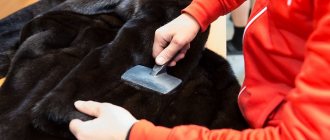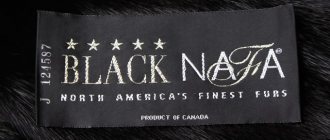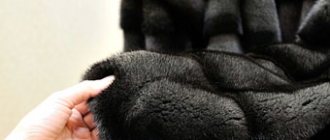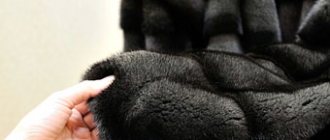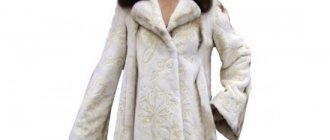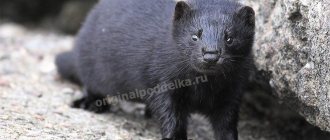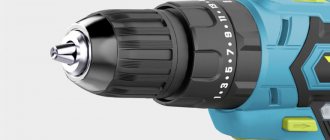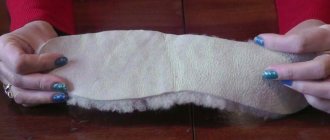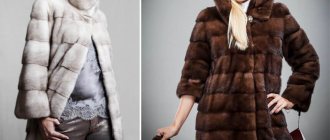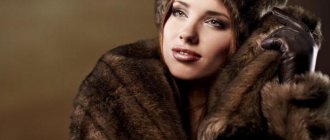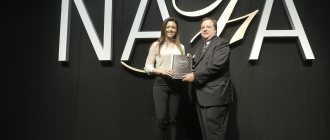Men say: “If you fall in love, then love the queen”; women answer: “If you wear a fur coat, it’s made from mink.” This item will not only protect its owner from the winter cold, but will also emphasize the good taste of the owner. But, unfortunately, not everyone can afford to buy a fur coat from a popular brand, and nearby, by the way, there are very budget offers on the market or even in a small, cozy store. The main thing here is not to buy a fake. Let's look at a few tips on how to distinguish real mink fur from a fake.
Bright-minded scientists are constantly working on ways to produce more and more beautiful and “similar” synthetic fur, not only of mink, but also of all known animals, the skins of which are used for sewing fur coats. To avoid getting such a miracle of technology, you should take a close look at the fur itself. If you run your hand over it , natural mink fur will be silky and soft. If we smooth it in the other direction and shake the product, the villi will quickly return to their original appearance, and the faux fur will remain disheveled.
How to identify mink fur
Mink belongs to the highest category of valuable furs along with sable, lynx, chinchilla and is characterized by increased wear resistance. A mink coat is worn for at least 6-8 winters, and can last 10-14 seasons.
It is for its beauty and durability that mink is so loved. But its quality varies, as does its price. The quality is mainly affected by the age of the fur, part of the skin and the type of mink: European, Scandinavian, American, etc. Fur coats are sewn from different parts. From the back they are more expensive, from the forehead and belly - cheaper.
Possible defects
You can avoid buying a fake if you know the common defects in mink fur. This should include:
- Uneven fur color, fading, abrasions. All these flaws indicate that old and low-quality fur was used for sewing.
- Don't know how to check quality? Then inspect the fur coat for red spots. If they are true, then this indicates that the animals were kept in iron cages. Rest assured that it is simply impossible to get rid of such stains.
- The fur fibers stick together, there is no gloss or shine. These defects indicate that the manufacturing technology was not strictly followed.
- The villi have an uneven surface. Their appearance is similar to the result of a poor-quality haircut. Most likely, the fur was damaged by animals. There is also no way to get rid of such a flaw.
- How else can you check the quality of a mink coat? You just need to feel it. If it feels like you are touching parchment paper, then the fur is dry. Such a product will quickly crack and fall apart.
If at least one of the presented flaws occurs, then it is better to refuse to purchase this product.
Self-assessment of fur quality
Let's try to determine the quality ourselves. The method is suitable for both individual skins and the entire product.
We evaluate it by touch.
Good quality fur feels smooth and soft to the touch. Moderately pliable, the fibers should return to their previous position when you run your hand over it. It should sting a little. Less wear-resistant fur, the same rabbit, softer and not itchy. Also look at the undercoat to see if it is thick enough.
Important: Good fur does not need painting. They cut and dye to disguise defects.
Let's look at the undercoat.
Mink comes in winter and summer. They differ in pile and undercoat. The winter coat has a thicker undercoat, is warmer, and costs less. Summer mink has a smoother, even and shiny appearance, there is less undercoat, and it costs more.
We check the flesh.
The mezdra is the lower part of the skin. She talks about age. Choose only products and skins with light, elastic core. Dark, brown - indicates the old age of the fur.
We evaluate visually.
Look at the coat or skin as a whole. The fur should be uniform and even. The fur on the back is denser and smoother. Lobes, bellies and other parts are less durable and beautiful. But they are significantly cheaper.
Important: The product made from the backs has absolutely no visible joints or undercoat. It gives the impression of cast skin. The coat of parts looks as if it is sewn from small semicircles, and it looks wavy.
Blow on the fur coat or set fire to some fur lint
Blow on the fur coat : on a natural mink you can see a clearly visible undercoat, which is the most difficult to counterfeit. However, if the seller strongly insists that this is still a real mink, pull out a couple of hairs from the fur coat and set it on fire. Natural ones will burn completely, releasing a distinct smell of burnt lint, but synthetic ones will begin to melt and smell like plastic.
How not to buy a rabbit instead of a mink?
The rabbit is more suitable as a cheap analogue of the chinchilla, especially the Rex breed. But they also pass it off as a mink, usually as a sheared one. The rabbit is not a bad animal. It grows quickly and is soft to the touch. Its price is one of the lowest on the fur market. It is not at all shameful for a young girl to have a vest or purse made of rabbit. It’s worse if, under the guise of an expensive and high-quality mink, they offer a rabbit fur coat. Lack of experience leads to the purchase of such “mink coats”. But this can be avoided. You must use keen eyes and a skeptical attitude.
• You can tell a rabbit from a mink by eye. Rabbit fur is soft and fluffy. Looks like cotton balls. Has virtually no undercoat. To bring the rabbit closer to the shorter hair of the mink, it is plucked. Spread the pile, look inside it to see if there is undercoat.
• Look at the color. The rabbit is one color, and the mink has small white hairs. The fur coat itself does not “play” in the sun and has no shine.
• The next test is by touch. Rabbit is much softer than mink. Feel more fur coats, after 10 you will understand where the fur is soft and where it is harder.
Important: A sheared mink feels prickly with trimmed guard hairs to the touch, but the rabbit still remains soft.
Types of fakes
There are different ways to distinguish a mink coat from a fake.
The question here is how exactly the parody is performed. There are artificial fur coats. But usually they are marked and have a special backing. It is technologically impossible to sew by analogy with natural fur.
In the case of fakes, we are often talking about the use of cheap fur. The seller says it's mink. But in fact, the fur of another animal was used. And it costs several times less.
Now let's see how to distinguish mink fur from fakes from other types of animals, as well as from artificial material.
Natural mink vs artificial
Objectively, the difference between them is huge. But modern technology and chemical developments have made it possible to achieve amazing similarities.
To find the differences, you will have to look more closely. Look at these moments:
- Weight
. A comparison cannot be avoided here. You need to take natural as well as artificial fur coats of approximately the same size. But the weight of a counterfeit genuine product will be significantly higher; - Shine of fur
. Mink has a unique silky sheen. And it is impossible to fake this feature qualitatively. A visual comparison shows this. Try ironing your fur coat against the lint. The artificial version will not return to its original position quickly; - Underfur
. Using your fingers, push the fur apart to the base. The natural material is thick and also has a dense underfur. Excellent heat retention. An artificial fake has no underfur. The base is made of fabric or thick knitwear; - Life time
. Synthetic fakes lose their appearance in 3-4 seasons. Natural and will retain its original beauty after 10 winters; - Warming properties
. The fake will not heat if the frost is -10-15 degrees Celsius. A natural fur coat will keep you warm in the most extreme cold.
Don’t believe those who say that faux mink is eco-fur. The material is made from nylon. It is a product of the oil industry.
Therefore, the fashionable concept of eco fur coats is nothing more than a marketing ploy. And this name is incorrect.
Mink versus other fur
We continue to discuss how to identify a mink from a fake. But now in comparison with cheaper, albeit natural, fur.
To reduce the cost of production, unscrupulous factories use cheap animal fur as a basis.
Therefore, it is worth learning how to identify a mink coat from a fake one made from the fur of other animals.
- Rabbits
. They have extremely soft pile. Also look at the color. Rabbit fur coats are uneven in color and do not have a uniform shine, unlike mink. Pinch your fur coat. If hairs remain in your hands, it is a fake. The mink is not plucked; - Beavers
. The skins are larger in size, and the fur is also tougher. The main difference is the thickness of the inner layer. Beaver coats will have a leathery base several times thicker than mink coats; - Marmots
. It is the fur of the marmot that is most often passed off as mink. The difference can be found in ductility. By smoothing the fur against the grain, the mink quickly recovers. The groundhog will have a shaggy effect. The marmot also tingles in the sun and also has a bluish tint. Natural mink coats do not have this effect; - Ferrets
. This fur is distinguished by a high awn and less dense underfur. The color is also different. The spine will be darker at the ends, and the underfur will be lighter. It is worth considering that the value of ferret fur coats is the same as that of mink. But if it is a matter of principle, then consider the distinctive features; - Honoriki
. The most difficult case. It's hard to find differences here. Honorik is the result of a cross between a ferret and a mink. A fake can be identified mainly by its black color, as well as by its thick brown undercoat.
Also remember that genuine mink products cannot be cheap.
If you see a suspiciously low price tag, then there is reason to suspect the seller of deception.
Plus, mink coats are almost weightless when compared with analogues. Especially with artificial ones. With low weight, such clothes are surprisingly warm. The warming effect is excellent. Mink is valued for these characteristics.
The difference between a good mink coat
A good mink coat looks expensive and rich. The quality is visible in everything: cut, tailoring, details and the level of the fur itself. The fur coat must be sewn from solid plates, from the backs. This is the most wear-resistant and beautiful option.
Sometimes a fur coat is sewn unraveled. For this technology, the skins are cut into a herringbone pattern and stitched back together. On the one hand, the fur coat has a flying silhouette, but, on the other hand, the product itself is less durable. If sewing is of poor quality, furrows may appear after the first season. When choosing such a model, pay special attention to the quality of the seams.
A good fur coat is well made. No protruding threads, no loose seams. The seams should not be visible at all. Expensive lining. After all, a fur coat is bought to last for many years, and the lining should also not wear out ahead of time.
Pay attention to the style. Super fashionable tailoring can look outdated after 1-2 seasons. If you do not plan to change your fur coat often, give preference to the classics.
Important: According to statistics, the most popular fur coat model is knee-length and with a hood. It's warm and you don't have to buy a hat.
A good fur coat is unlikely to be made in a handicraft industry. The master must understand furs, be able to select skins by color and quality for one product, and know all the intricacies of technology. Knowledge and skills are acquired over years and no one will exchange them for sewing low-quality products. Large showrooms work directly with well-known factories, offering customers the best models.
Differences between dyed skins and pure, natural fur
Fur is dyed not only to give it a fashionable bright color. Often, painting simply disguises a low-quality item, sewn from skins of different colors or even made up of scraps.
It is, of course, not difficult to distinguish a fur coat, which the manufacturer has given a bright red or blue color, from undyed fur. But recognizing a thing painted to look natural is quite difficult.
| Characteristic | Dyed skin | Clean fur |
| Leather base | The leather base is dark, from black, brown to gray. The color duplicates the tone of the pile. | The skin is beige, an even light cream tone, regardless of the color of the pile. |
| Black color | Pure bright black color is the result of dyeing. | There are no completely black minks; this color always has a tint, cast brownish or grayish. |
| Variation in appearance under different lighting conditions | The color is deep, pure, without shimmer and does not change when lighting changes. | There are differences in appearance under different lighting conditions. The pile glitters and shimmers. |
It is extremely important to know whether the fur has been dyed or not. The dyeing procedure weakens the guard hairs, reduces the density of the undercoat and negatively affects other characteristics of the fur. Instructions for caring for a dyed fur coat differ from the recommendations for products made from pure fur.
Natural mink can be dyed and then lightened the leather base. As a rule, fur coats are not made from such skins; they are used to make accessories.
This finishing method destroys the fur and weakens the nests of guard hair bulbs. A fur coat made from skins treated in this way will become unusable within one season.
It is almost impossible to visually identify such fur, but it is not particularly difficult to distinguish it when feeling the fur coat. The undercoat on such fur is easy to tear out from the leather base, as is the guard hair; the lint is practically not retained in the skin.
Distinctive characteristics of products from different countries
Expert advice and recommendations regarding mink products differ depending on the country in which the animals were raised. Scandinavian fur products are considered to be the best.
Scandinavian fur is divided as follows:
- Finnish, with product labeling – Saga Furs.
- Danish, marked as Copenhagen Furs.
Finnish products are distinguished by high guard hairs and abundant undercoat. Danish minks look different. The guard hairs are set low and lie close to the undercoat. Danish skins do not look fluffy.
In terms of their characteristics, the Ukrainian mink is slightly inferior to them. Its underfur is considered not so thick, and its awn is longer. Greek fur coats are more popular. There is also an opinion that in Greece the cost of a fur coat is much less. Some go on special trips to buy fur products.
But on the territory of any country you can find manufacturers of both high-quality production and not very high-quality ones. A good and real fur product will definitely not cost too much. That is why you should not take risks by making expensive purchases in a recreation area.
Fur coats from Russian and Chinese manufacturers are much cheaper. Now some Chinese manufacturers have also learned to create fur products from high-quality fur. But you can also find a large number of fakes among such fur coats. It is for this reason that it will be very disappointing to buy a Chinese fur coat at the price of a Canadian or Greek one.
Buy from those who are trustworthy
Real American, Scandinavian, Greek mink coats are sold in specialized fur salons and retail outlets from large fur factories. Sellers of this level guarantee the quality of fur and tailoring and provide a significant guarantee. A certificate is issued for each product; its data matches the information on the fur coat tag. On a fake, the tag may say weasel (Rabbit), kolynsky (marmot). A person who does not know English may not pay attention to this. The seller, naturally, will not explain. A real mink tag may only say mink (mink in English) or vison (French).
There are many differences between fake and real mink. To avoid becoming a victim of scammers, you need to study them. A little time, scrupulousness, careful reading of the documentation, and a long-awaited natural product will appear in your wardrobe.
